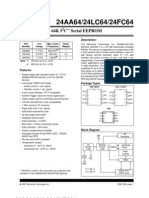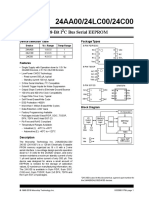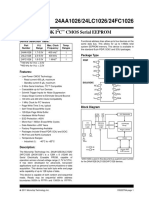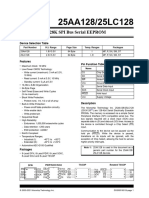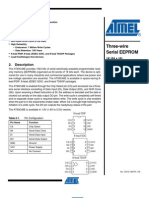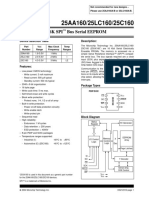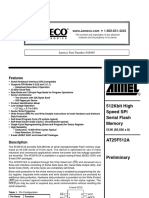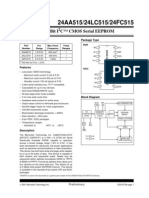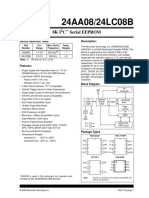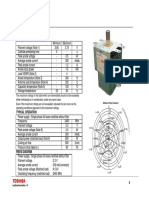93C86
93C86
Uploaded by
cgmannerheimCopyright:
Available Formats
93C86
93C86
Uploaded by
cgmannerheimCopyright
Available Formats
Share this document
Did you find this document useful?
Is this content inappropriate?
Copyright:
Available Formats
93C86
93C86
Uploaded by
cgmannerheimCopyright:
Available Formats
Not recommended for new designs
Please use 93LC76C or 93LC86C.
93C76/86
8K/16K 5.0V Microwire Serial EEPROM
Features: Package Types
Single 5.0V supply
PDIP Package
Low-power CMOS technology
- 1 mA active current typical
ORG pin selectable memory configuration CS 1 8 VCC
93C76/86
1024 x 8- or 512 x 16-bit organization (93C76) 7
CLK 2 PE
2048 x 8- or 1024 x 16-bit organization (93C86)
DI 3 6 ORG
Self-timed erase and write cycles
DO 4 5 VSS
(including auto-erase)
Automatic ERAL before WRAL
Power on/off data protection circuitry
SOIC Package
Industry standard 3-wire serial I/O
Device status signal during erase/write cycles
1 8
93C76/86
Sequential read function CS VCC
1,000,000 erase/write cycles ensured CLK 2 7 PE
Data retention > 200 years DI 3 6 ORG
DO 4 5 VSS
8-pin PDIP/SOIC package
Temperature ranges supported
- Commercial (C): 0C to +70C
- Industrial (I): -40C to +85C Block Diagram
- Automotive (E) -40C to +125C
VCC VSS
Description:
The Microchip Technology Inc. 93C76/86 are 8K and
Memory Address
16K low voltage serial Electrically Erasable PROMs. Array Decoder
The device memory is configured as x8 or x16 bits
depending on the ORG pin setup. Advanced CMOS
technology makes these devices ideal for low power
nonvolatile memory applications. These devices also Address
Counter
have a Program Enable (PE) pin to allow the user to
write protect the entire contents of the memory array.
The 93C76/86 is available in standard 8-pin PDIP and
8-pin surface mount SOIC packages. Data Output
Register Buffer
DO
DI
Mode
PE Decode
CS Logic
Clock
CLK
Generator
1996-2012 Microchip Technology Inc. DS21132F-page 1
93C76/86
1.0 ELECTRICAL CHARACTERISTICS
Absolute Maximum Ratings()
VCC .............................................................................................................................................................................7.0V
All inputs and outputs w.r.t. VSS ........................................................................................................ -0.6V to Vcc + 1.0V
Storage temperature ...............................................................................................................................-65C to +150C
Ambient temperature with power applied ................................................................................................-40C to +125C
Soldering temperature of leads (10 seconds) .......................................................................................................+300C
ESD protection on all pins ..........................................................................................................................................4 kV
NOTICE: Stresses above those listed under Absolute Maximum Ratings may cause permanent damage to the
device. This is a stress rating only and functional operation of the device at these or any other conditions above those
indicated in the operational listings of this specification is not implied. Exposure to Absolute Maximum Rating
conditions for extended periods may affect device reliability.
1.1 AC Test Conditions
AC Waveform:
VLO = 2.0V
VHI = Vcc - 0.2V (Note 1)
VHI = 4.0V for (Note 2)
Timing Measurement Reference Level
Input 0.5 VCC
Output 0.5 VCC
Note 1: For VCC 4.0V
2: For VCC > 4.0V
DS21132F-page 2 1996-2012 Microchip Technology Inc.
93C76/86
TABLE 1-1: DC CHARACTERISTICS
Applicable over recommended operating ranges shown below unless otherwise noted:
VCC = +4.5V to +5.5V
DC CHARACTERISTICS Commercial (C): TA = 0C to -40C
Industrial (I): TA = -40C to +85C
Automotive (E): TA = -40C to +125C
Parameter Symbol Min. Max. Units Conditions
High-level input voltage VIH1 2.0 VCC +1 V
Low-level input voltage VIL1 -0.3 0.8 V
Low-level output voltage VOL1 0.4 V IOL = 2.1 mA; VCC = 4.5V
VOL2 0.2 V IOL =100 A; VCC = 4.5V
High-level output voltage VOH1 2.4 V IOH = -400 A; VCC = 4.5V
VOH2 VCC-0.2 V IOH = -100 A; VCC = 4.5V.
Input leakage current ILI -10 10 A VIN = 0.1V to VCC
Output leakage current ILO -10 10 A VOUT = 0.1V to VCC
Pin capacitance CINT 7 pF (Note 1)
(all inputs/outputs) TA = +25C, FCLK = 1 MHz
Operating current ICC write 3 mA FCLK = 2 MHz; VCC = 5.5V
ICC read 1.5 mA FCLK = 2 MHz; VCC = 5.5V
Standby current ICCS 100 A CLK = CS = 0V; VCC = 5.5V
DI = PE = VSS
ORG = VSS or VCC
Note 1: This parameter is periodically sampled and not 100% tested.
TABLE 1-2: AC CHARACTERISTICS
Applicable over recommended operating ranges shown below unless otherwise noted:
VCC = +4.5V to +5.5V
AC CHARACTERISTICS Commercial (C): TA = 0C to -40C
Industrial (I): TA = -40C to +85C
Automotive (E): TA = -40C to +125C
Parameter Symbol Min. Max. Units Conditions
Clock frequency FCLK 2 MHz Vcc 4.5V
Clock high time TCKH 300 ns
Clock low time TCKL 200 ns
Chip select setup time TCSS 50 ns Relative to CLK
Chip select hold time TCSH 0 ns
Chip select low time TCSL 250 ns Relative to CLK
Data input setup time TDIS 100 ns Relative to CLK
Data input hold time TDIH 100 ns Relative to CLK
Data output delay time TPD 400 ns CL = 100 pF
Data output disable time TCZ 100 ns (Note 1)
Status valid time TSV 500 ns CL = 100 pF
Program cycle time TWC 10 ms Erase/Write mode (Note 2)
TEC 15 ms ERAL mode
TWL 30 ms WRAL mode
Endurance 1M cycles 25C, VCC = 5.0V, Block mode
(Note 3)
Note 1: This parameter is periodically sampled and not 100% tested.
2: Typical program cycle is 4 ms per word.
3: This parameter is not tested but ensured by characterization. For endurance estimates in a specific
application, please consult the Total Endurance Model which can be obtained from Microchips web site
at www.microchip.com.
1996-2012 Microchip Technology Inc. DS21132F-page 3
93C76/86
TABLE 1-3: INSTRUCTION SET FOR 93C76: ORG=1 (X16 ORGANIZATION)
Instruction SB Opcode Address Data In Data Out Req. CLK Cycles
READ 1 10 X A8 A7 A6 A5 A4 A3 A2 A1 A0 D15 - D0 29
EWEN 1 00 1 1 X X X X X X X X High-Z 13
ERASE 1 11 X A8 A7 A6 A5 A4 A3 A2 A1 A0 (RDY/BSY) 13
ERAL 1 00 1 0 X X X X X X X X (RDY/BSY) 13
WRITE 1 01 X A8 A7 A6 A5 A4 A3 A2 A1 A0 D15 - D0 (RDY/BSY) 29
WRAL 1 00 0 1 X X X X X X X X D15 - D0 (RDY/BSY) 29
EWDS 1 00 0 0 X X X X X X X X High-Z 13
TABLE 1-4: INSTRUCTION SET FOR 93C76: ORG=0 (X8 ORGANIZATION)
Req. CLK
Instruction SB Opcode Address Data In Data Out
Cycles
READ 1 10 X A9 A8 A7 A6 A5 A4 A3 A2 A1 A0 D7 - D0 22
EWEN 1 00 1 1 X X X X X X X X X High-Z 14
ERASE 1 11 X A9 A8 A7 A6 A5 A4 A3 A2 A1 A0 (RDY/BSY) 14
ERAL 1 00 1 0 X X X X X X X X X (RDY/BSY) 14
WRITE 1 01 X A9 A8 A7 A6 A5 A4 A3 A2 A1 A0 D7 - D0 (RDY/BSY) 22
WRAL 1 00 0 1 X X X X X X X X X D7 - D0 (RDY/BSY) 22
EWDS 1 00 0 0 X X X X X X X X X High-Z 14
TABLE 1-5: INSTRUCTION SET FOR 93C86: ORG=1 (X16 ORGANIZATION)
Instruction SB Opcode Address Data In Data Out Req. CLK Cycles
READ 1 10 A9 A8 A7 A6 A5 A4 A3 A2 A1 A0 D15 - D0 29
EWEN 1 00 1 1 X X X X X X X X High-Z 13
ERASE 1 11 A9 A8 A7 A6 A5 A4 A3 A2 A1 A0 (RDY/BSY) 13
ERAL 1 00 1 0 X X X X X X X X (RDY/BSY) 13
WRITE 1 01 A9 A8 A7 A6 A5 A4 A3 A2 A1 A0 D15 - D0 (RDY/BSY) 29
WRAL 1 00 0 1 X X X X X X X X D15 - D0 (RDY/BSY) 29
EWDS 1 00 0 0 X X X X X X X X High-Z 13
TABLE 1-6: INSTRUCTION SET FOR 93C86: ORG=0 (X8 ORGANIZATION)
Instruction SB Opcode Address Data In Data Out Req. CLK Cycles
READ 1 10 A10 A9 A8 A7 A6 A5 A4 A3 A2 A1 A0 D7 - D0 22
EWEN 1 00 1 1 X X X X X X X X X High-Z 14
ERASE 1 11 A10 A9 A8 A7 A6 A5 A4 A3 A2 A1 A0 (RDY/BSY) 14
ERAL 1 00 1 0 X X X X X X X X X (RDY/BSY) 14
WRITE 1 01 A10 A9 A8 A7 A6 A5 A4 A3 A2 A1 A0 D7 - D0 (RDY/BSY) 22
WRAL 1 00 0 1 X X X X X X X X X D7 - D0 (RDY/BSY) 22
EWDS 1 00 0 0 X X X X X X X X X High-Z 14
DS21132F-page 4 1996-2012 Microchip Technology Inc.
93C76/86
2.0 PRINCIPLES OF OPERATION 2.3 Erase/Write Enable and Disable
(EWEN, EWDS)
When the ORG pin is connected to VCC, the x16 orga-
nization is selected. When it is connected to ground, The 93C76/86 powers up in the Erase/Write Disable
the x8 organization is selected. Instructions, addresses (EWDS) state. All programming modes must be
and write data are clocked into the DI pin on the rising preceded by an Erase/Write Enable (EWEN) instruction.
edge of the clock (CLK). The DO pin is normally held in Once the EWEN instruction is executed, programming
a high-Z state except when reading data from the remains enabled until an EWDS instruction is executed
device, or when checking the Ready/Busy status or VCC is removed from the device. To protect against
during a programming operation. The Ready/Busy accidental data disturb, the EWDS instruction can be
status can be verified during an erase/write operation used to disable all erase/write functions and should
by polling the DO pin; DO low indicates that program- follow all programming operations. Execution of a READ
ming is still in progress, while DO high indicates the instruction is independent of both the EWEN and EWDS
device is ready. The DO will enter the high-impedance instructions.
state on the falling edge of the CS.
2.4 Data Protection
2.1 Start Condition
During power-up, all programming modes of operation
The Start bit is detected by the device if CS and DI are are inhibited until VCC has reached a level greater than
both high with respect to the positive edge of CLK for 1.4V. During power-down, the source data protection
the first time. circuitry acts to inhibit all programming modes when
Before a Start condition is detected, CS, CLK and DI VCC has fallen below 1.4V.
may change in any combination (except to that of a The EWEN and EWDS commands give additional
Start condition), without resulting in any device opera- protection against accidentally programming during
tion (Read, Write, Erase, EWEN, EWDS, ERAL and normal operation.
WRAL). As soon as CS is high, the device is no longer
After power-up, the device is automatically in the
in the Standby mode.
EWDS mode. Therefore, an EWEN instruction must be
An instruction following a Start condition will only be performed before any ERASE or WRITE instruction can
executed if the required amount of opcode, address be executed.
and data bits for any particular instruction are clocked
in.
After execution of an instruction (i.e., clock in or out of
the last required address or data bit) CLK and DI
become don't care bits until a new Start condition is
detected.
2.2 DI/DO
It is possible to connect the Data In and Data Out pins
together. However, with this configuration it is possible
for a bus conflict to occur during the dummy zero
that precedes the read operation, if A0 is a logic high
level. Under such a condition the voltage level seen at
Data Out is undefined and will depend upon the relative
impedances of Data Out and the signal source driving
A0. The higher the current sourcing capability of A0,
the higher the voltage at the Data Out pin.
1996-2012 Microchip Technology Inc. DS21132F-page 5
93C76/86
3.0 DEVICE OPERATION 3.4 Erase All (ERAL)
The ERAL instruction will erase the entire memory array
3.1 Read to the logical 1 state. The ERAL cycle is identical to
The READ instruction outputs the serial data of the the erase cycle except for the different opcode. The
addressed memory location on the DO pin. A dummy ERAL cycle is completely self-timed and commences
zero bit precedes the 16-bit (x16 organization) or 8-bit on the rising edge of the last address bit (A0). Note that
(x8 organization) output string. The output data bits will the Least Significant 8 or 9 address bits are "dont care"
toggle on the rising edge of the CLK and are stable bits, depending on selection of x16 or x8 mode. Clock-
after the specified time delay (TPD). Sequential read is ing of the CLK pin is not necessary after the device has
possible when CS is held high and clock transitions entered the self clocking mode. The ERAL instruction is
continue. The memory address pointer will automati- ensured at Vcc = +4.5V to +5.5V.
cally increment and output data sequentially. The DO pin indicates the Ready/Busy status of the
device if the CS is high. The Ready/Busy status will be
3.2 Erase displayed on the DO pin until the next Start bit is
received as long as CS is high. Bringing the CS low will
The ERASE instruction forces all data bits of the place the device in Standby mode and cause the DO
specified address to the logical 1 state. The self-timed pin to enter the high-impedance state. DO at logical 0
programming cycle is initiated on the rising edge of indicates that programming is still in progress. DO at
CLK as the last address bit (A0) is clocked in. At this logical 1 indicates that the entire device has been
point, the CLK, CS and DI inputs become dont cares. erased and is ready for another instruction.
The DO pin indicates the Ready/Busy status of the The ERAL cycle takes 15 ms maximum (8 ms typical).
device if the CS is high. The Ready/Busy status will be
displayed on the DO pin until the next Start bit is 3.5 Write All (WRAL)
received as long as CS is high. Bringing the CS low will
place the device in Standby mode and cause the DO The WRAL instruction will write the entire memory array
pin to enter the high-impedance state. DO at logical 0 with the data specified in the command. The WRAL
indicates that programming is still in progress. DO at cycle is completely self-timed and commences on the
logical 1 indicates that the register at the specified rising edge of the last address bit (A0). Note that the
address has been erased and the device is ready for Least Significant 8 or 9 address bits are dont cares,
another instruction. depending on selection of x16 or x8 mode. Clocking of
The erase cycle takes 3 ms per word (typical). the CLK pin is not necessary after the device has
entered the self clocking mode. The WRAL command
does include an automatic ERAL cycle for the device.
3.3 Write Therefore, the WRAL instruction does not require an
The WRITE instruction is followed by 16 bits (or by 8 ERAL instruction but the chip must be in the EWEN
bits) of data to be written into the specified address. status. The WRAL instruction is ensured at Vcc = +4.5V
The self-timed programming cycle is initiated on the to +5.5V.
rising edge of CLK as the last data bit (D0) is clocked The DO pin indicates the Ready/Busy status of the
in. At this point, the CLK, CS and DI inputs become device if the CS is high. The Ready/Busy status will be
dont cares. displayed on the DO pin until the next Start bit is
The DO pin indicates the Ready/Busy status of the received as long as CS is high. Bringing the CS low will
device if the CS is high. The Ready/Busy status will be place the device in Standby mode and cause the DO
displayed on the DO pin until the next Start bit is pin to enter the high-impedance state. DO at logical 0
received as long as CS is high. Bringing the CS low will indicates that programming is still in progress. DO at
place the device in Standby mode and cause the DO logical 1 indicates that the entire device has been
pin to enter the high-impedance state. DO at logical 0 written and is ready for another instruction.
indicates that programming is still in progress. DO at The WRAL cycle takes 30 ms maximum (16 ms
logical 1 indicates that the register at the specified typical).
address has been written and the device is ready for
another instruction.
The write cycle takes 3 ms per word (typical).
DS21132F-page 6 1996-2012 Microchip Technology Inc.
93C76/86
FIGURE 3-1: SYNCHRONOUS DATA TIMING
VIH
CS TCSS TCKH TCKL
VIL
VIH TCSH
CLK
VIL TDIH
TDIS
VIH
DI
VIL
TPD TCZ
VOH TPD
DO
(Read) VOL TCZ
TSV
VOH
DO
(Program) VOL Status Valid
The memory automatically cycles to the next register.
FIGURE 3-2: READ
TCSL
CS
CLK
DI 1 1 0 AN ... A0
High-impedance ... ...
DO 0 DN D0 DN D0
FIGURE 3-3: EWEN
EWEN TCSL
CS
CLK
DI 1 0 0 1 1 x ... x
ORG = VCC, 8 XS
ORG = VSS, 9 XS
1996-2012 Microchip Technology Inc. DS21132F-page 7
93C76/86
FIGURE 3-4: EWDS
TCSL
CS
CLK
DI 1 0 0 0 0 x ... x
ORG = VCC, 8 Xs
ORG = VSS, 9 XS
FIGURE 3-5: WRITE
CS Standby
CLK
DI 1 0 1 AN ... A0 DN ... D0
TCZ
High-impedance Busy Ready
DO
TWC
FIGURE 3-6: WRAL
Standby
CS
CLK
DI 1 0 0 0 1 x ... x DN ... D0
TCZ
High-impedance Busy
DO Ready
ORG = VCC, 8 Xs TWL
ORG = VSS, 9 Xs Ensure at Vcc = +4.5V to +5.5V.
DS21132F-page 8 1996-2012 Microchip Technology Inc.
93C76/86
FIGURE 3-7: ERASE
CS Standby
CLK
DI 1 1 1 AN ... ... A0
TCZ
High-impedance
DO Busy Ready
TWC
FIGURE 3-8: ERAL
CS Standby
CLK
DI 1 0 0 1 0 x ... x
TCZ
High-impedance
DO Busy Ready
TEC
ORG = VCC, 8 Xs
ORG = VSS, 9 Xs Ensure at VCC = +4.5V to +5.5V.
1996-2012 Microchip Technology Inc. DS21132F-page 9
93C76/86
4.0 PIN DESCRIPTIONS After detection of a Start condition the specified number
of clock cycles (respectively low-to-high transitions of
CLK) must be provided. These clock cycles are
TABLE 4-1: PIN FUNCTION TABLE
required to clock in all opcode, address, and data bits
Name Function before an instruction is executed (see Table 1-3
CS Chip Select through Table 1-6 for more details). CLK and DI then
become don't care inputs waiting for a new Start
CLK Serial Data Clock condition to be detected.
DI Serial Data Input
DO Serial Data Output Note: CS must go low between consecutive
VSS Ground instructions, except when performing a
ORG Memory Configuration sequential read (Refer to Section 3.1
Read for more detail on sequential
PE Program Enable reads).
VCC Power Supply
4.3 Data In (DI)
4.1 Chip Select (CS)
Data In is used to clock in a Start bit, opcode, address
A high level selects the device. A low level deselects and data synchronously with the CLK input.
the device and forces it into Standby mode. However, a
programming cycle which is already initiated will be 4.4 Data Out (DO)
completed, regardless of the CS input signal. If CS is
brought low during a program cycle, the device will go Data Out is used in the Read mode to output data
into Standby mode as soon as the programming cycle synchronously with the CLK input (TPD after the
is completed. positive edge of CLK).
CS must be low for 250 ns minimum (TCSL) between This pin also provides Ready/Busy status information
consecutive instructions. If CS is low, the internal during erase and write cycles. Ready/Busy status
control logic is held in a RESET status. information is available when CS is high. It will be
displayed until the next Start bit occurs as long as CS
stays high.
4.2 Serial Clock (CLK)
The Serial Clock is used to synchronize the communi- 4.5 Organization (ORG)
cation between a master device and the 93C76/86.
Opcode, address and data bits are clocked in on the When ORG is connected to VCC, the x16 memory
positive edge of CLK. Data bits are also clocked out on organization is selected. When ORG is tied to VSS, the
the positive edge of CLK. x8 memory organization is selected. There is an
internal pull-up resistor on the ORG pin that will select
CLK can be stopped anywhere in the transmission x16 organization when left unconnected.
sequence (at high or low level) and can be continued
anytime with respect to clock high time (TCKH) and
clock low time (TCKL). This gives the controlling master
4.6 Program Enable (PE)
freedom in preparing opcode, address and data. This pin allows the user to enable or disable the ability
CLK is a don't care if CS is low (device deselected). If to write data to the memory array. If the PE pin is
CS is high, but Start condition has not been detected, floated or tied to VCC, the device can be programmed.
any number of clock cycles can be received by the If the PE pin is tied to VSS, programming will be
device without changing its status (i.e., waiting for Start inhibited. There is an internal pull-up on this device that
condition). enables programming if this pin is left floating.
CLK cycles are not required during the self-timed write
(i.e., auto erase/write) cycle.
DS21132F-page 10 1996-2012 Microchip Technology Inc.
93C76/86
5.0 PACKAGING INFORMATION
5.1 Package Marking Information
8-Lead PDIP Example
XXXXXXXX 93C76
XXXXXNNN 017
YYWW 0410
8-Lead SOIC (.150) Example
XXXXXXXX 93C86
XXXXYYWW /SN0410
NNN 017
Legend: XX...X Customer-specific information
Y Year code (last digit of calendar year)
YY Year code (last 2 digits of calendar year)
WW Week code (week of January 1 is week 01)
NNN Alphanumeric traceability code
e3 Pb-free JEDEC designator for Matte Tin (Sn)
* This package is Pb-free. The Pb-free JEDEC designator ( e3 )
can be found on the outer packaging for this package.
Note: In the event the full Microchip part number cannot be marked on one line, it will
be carried over to the next line, thus limiting the number of available
characters for customer-specific information.
1996-2012 Microchip Technology Inc. DS21132F-page 11
93C76/86
8-Lead Plastic Dual In-line (P) 300 mil Body (PDIP)
Note: For the most current package drawings, please see the Microchip Packaging Specification located
at http://www.microchip.com/packaging
E1
n 1
A A2
L
c
A1
B1
p
eB B
Units INCHES* MILLIMETERS
Dimension Limits MIN NOM MAX MIN NOM MAX
Number of Pins n 8 8
Pitch p .100 2.54
Top to Seating Plane A .140 .155 .170 3.56 3.94 4.32
Molded Package Thickness A2 .115 .130 .145 2.92 3.30 3.68
Base to Seating Plane A1 .015 0.38
Shoulder to Shoulder Width E .300 .313 .325 7.62 7.94 8.26
Molded Package Width E1 .240 .250 .260 6.10 6.35 6.60
Overall Length D .360 .373 .385 9.14 9.46 9.78
Tip to Seating Plane L .125 .130 .135 3.18 3.30 3.43
Lead Thickness c .008 .012 .015 0.20 0.29 0.38
Upper Lead Width B1 .045 .058 .070 1.14 1.46 1.78
Lower Lead Width B .014 .018 .022 0.36 0.46 0.56
Overall Row Spacing eB .310 .370 .430 7.87 9.40 10.92
Mold Draft Angle Top 5 10 15 5 10 15
Mold Draft Angle Bottom 5 10 15 5 10 15
* Controlling Parameter
Significant Characteristic
Notes:
Dimensions D and E1 do not include mold flash or protrusions. Mold flash or protrusions shall not exceed
.010 (0.254mm) per side.
JEDEC Equivalent: MS-001
Drawing No. C04-018
DS21132F-page 12 1996-2012 Microchip Technology Inc.
93C76/86
8-Lead Plastic Small Outline (SN) Narrow, 150 mil Body (SOIC)
Note: For the most current package drawings, please see the Microchip Packaging Specification located
at http://www.microchip.com/packaging
E1
D
2
B n 1
h
45
c
A A2
L A1
Units INCHES* MILLIMETERS
Dimension Limits MIN NOM MAX MIN NOM MAX
Number of Pins n 8 8
Pitch p .050 1.27
Overall Height A .053 .061 .069 1.35 1.55 1.75
Molded Package Thickness A2 .052 .056 .061 1.32 1.42 1.55
Standoff A1 .004 .007 .010 0.10 0.18 0.25
Overall Width E .228 .237 .244 5.79 6.02 6.20
Molded Package Width E1 .146 .154 .157 3.71 3.91 3.99
Overall Length D .189 .193 .197 4.80 4.90 5.00
Chamfer Distance h .010 .015 .020 0.25 0.38 0.51
Foot Length L .019 .025 .030 0.48 0.62 0.76
Foot Angle 0 4 8 0 4 8
Lead Thickness c .008 .009 .010 0.20 0.23 0.25
Lead Width B .013 .017 .020 0.33 0.42 0.51
Mold Draft Angle Top 0 12 15 0 12 15
Mold Draft Angle Bottom 0 12 15 0 12 15
* Controlling Parameter
Significant Characteristic
Notes:
Dimensions D and E1 do not include mold flash or protrusions. Mold flash or protrusions shall not exceed
.010 (0.254mm) per side.
JEDEC Equivalent: MS-012
Drawing No. C04-057
1996-2012 Microchip Technology Inc. DS21132F-page 13
93C76/86
APPENDIX A: REVISION HISTORY
Revision E
Added note to page 1 header (Not recommended for
new designs).
Added Section 5.0: Package Marking Information.
Added On-line Support page.
Updated document format.
Revision F
Added a note to each package outline drawing.
DS21132F-page 14 1996-2012 Microchip Technology Inc.
93C76/86
THE MICROCHIP WEB SITE CUSTOMER SUPPORT
Microchip provides online support via our WWW site at Users of Microchip products can receive assistance
www.microchip.com. This web site is used as a means through several channels:
to make files and information easily available to Distributor or Representative
customers. Accessible by using your favorite Internet
Local Sales Office
browser, the web site contains the following
information: Field Application Engineer (FAE)
Technical Support
Product Support Data sheets and errata,
application notes and sample programs, design Customers should contact their distributor,
resources, users guides and hardware support representative or field application engineer (FAE) for
documents, latest software releases and archived support. Local sales offices are also available to help
software customers. A listing of sales offices and locations is
General Technical Support Frequently Asked included in the back of this document.
Questions (FAQ), technical support requests, Technical support is available through the web site
online discussion groups, Microchip consultant at: http://microchip.com/support
program member listing
Business of Microchip Product selector and
ordering guides, latest Microchip press releases,
listing of seminars and events, listings of
Microchip sales offices, distributors and factory
representatives
CUSTOMER CHANGE NOTIFICATION
SERVICE
Microchips customer notification service helps keep
customers current on Microchip products. Subscribers
will receive e-mail notification whenever there are
changes, updates, revisions or errata related to a
specified product family or development tool of interest.
To register, access the Microchip web site at
www.microchip.com. Under Support, click on
Customer Change Notification and follow the
registration instructions.
1996-2012 Microchip Technology Inc. DS21132F-page 15
93C76/86
READER RESPONSE
It is our intention to provide you with the best documentation possible to ensure successful use of your Microchip
product. If you wish to provide your comments on organization, clarity, subject matter, and ways in which our
documentation can better serve you, please FAX your comments to the Technical Publications Manager at
(480) 792-4150.
Please list the following information, and use this outline to provide us with your comments about this document.
TO: Technical Publications Manager Total Pages Sent ________
RE: Reader Response
From: Name
Company
Address
City / State / ZIP / Country
Telephone: (_______) _________ - _________ FAX: (______) _________ - _________
Application (optional):
Would you like a reply? Y N
Device: 93C76/86 Literature Number: DS21132F
Questions:
1. What are the best features of this document?
2. How does this document meet your hardware and software development needs?
3. Do you find the organization of this document easy to follow? If not, why?
4. What additions to the document do you think would enhance the structure and subject?
5. What deletions from the document could be made without affecting the overall usefulness?
6. Is there any incorrect or misleading information (what and where)?
7. How would you improve this document?
DS21132F-page 16 1996-2012 Microchip Technology Inc.
93C76/86
PRODUCT IDENTIFICATION SYSTEM
To order or obtain information, e.g., on pricing or delivery, refer to the factory or the listed sales office.
PART NO. X /XX XXX
Device Temperature Package Pattern
Range
Device 93C76/86: Microwire Serial EEPROM
93C76T/86T: Microwire Serial EEPROM (Tape and Reel)
Temperature Range Blank = 0C to +70C
I = -40C to +85C
E = -40C to +125C
Package P = Plastic DIP (300 mil Body), 8-lead
SN = Plastic SOIC (150 mil Body), 8-lead
Sales and Support
Data Sheets
Products supported by a preliminary Data Sheet may have an errata sheet describing minor operational differences and
recommended workarounds. To determine if an errata sheet exists for a particular device, please contact one of the following:
1. Your local Microchip sales office
2. The Microchip Worldwide Site (www.microchip.com)
Please specify which device, revision of silicon and Data Sheet (include Literature #) you are using.
New Customer Notification System
Register on our web site (www.microchip.com/cn) to receive the most current information on our products.
1996-2012 Microchip Technology Inc. DS21132F-page 17
93C76/86
NOTES:
DS21132F-page 18 1996-2012 Microchip Technology Inc.
Note the following details of the code protection feature on Microchip devices:
Microchip products meet the specification contained in their particular Microchip Data Sheet.
Microchip believes that its family of products is one of the most secure families of its kind on the market today, when used in the
intended manner and under normal conditions.
There are dishonest and possibly illegal methods used to breach the code protection feature. All of these methods, to our
knowledge, require using the Microchip products in a manner outside the operating specifications contained in Microchips Data
Sheets. Most likely, the person doing so is engaged in theft of intellectual property.
Microchip is willing to work with the customer who is concerned about the integrity of their code.
Neither Microchip nor any other semiconductor manufacturer can guarantee the security of their code. Code protection does not
mean that we are guaranteeing the product as unbreakable.
Code protection is constantly evolving. We at Microchip are committed to continuously improving the code protection features of our
products. Attempts to break Microchips code protection feature may be a violation of the Digital Millennium Copyright Act. If such acts
allow unauthorized access to your software or other copyrighted work, you may have a right to sue for relief under that Act.
Information contained in this publication regarding device Trademarks
applications and the like is provided only for your convenience The Microchip name and logo, the Microchip logo, dsPIC,
and may be superseded by updates. It is your responsibility to
FlashFlex, KEELOQ, KEELOQ logo, MPLAB, PIC, PICmicro,
ensure that your application meets with your specifications.
PICSTART, PIC32 logo, rfPIC, SST, SST Logo, SuperFlash
MICROCHIP MAKES NO REPRESENTATIONS OR and UNI/O are registered trademarks of Microchip Technology
WARRANTIES OF ANY KIND WHETHER EXPRESS OR
Incorporated in the U.S.A. and other countries.
IMPLIED, WRITTEN OR ORAL, STATUTORY OR
OTHERWISE, RELATED TO THE INFORMATION, FilterLab, Hampshire, HI-TECH C, Linear Active Thermistor,
INCLUDING BUT NOT LIMITED TO ITS CONDITION, MTP, SEEVAL and The Embedded Control Solutions
QUALITY, PERFORMANCE, MERCHANTABILITY OR Company are registered trademarks of Microchip Technology
FITNESS FOR PURPOSE. Microchip disclaims all liability Incorporated in the U.S.A.
arising from this information and its use. Use of Microchip Silicon Storage Technology is a registered trademark of
devices in life support and/or safety applications is entirely at Microchip Technology Inc. in other countries.
the buyers risk, and the buyer agrees to defend, indemnify and
Analog-for-the-Digital Age, Application Maestro, BodyCom,
hold harmless Microchip from any and all damages, claims,
chipKIT, chipKIT logo, CodeGuard, dsPICDEM,
suits, or expenses resulting from such use. No licenses are
dsPICDEM.net, dsPICworks, dsSPEAK, ECAN,
conveyed, implicitly or otherwise, under any Microchip
ECONOMONITOR, FanSense, HI-TIDE, In-Circuit Serial
intellectual property rights.
Programming, ICSP, Mindi, MiWi, MPASM, MPF, MPLAB
Certified logo, MPLIB, MPLINK, mTouch, Omniscient Code
Generation, PICC, PICC-18, PICDEM, PICDEM.net, PICkit,
PICtail, REAL ICE, rfLAB, Select Mode, SQI, Serial Quad I/O,
Total Endurance, TSHARC, UniWinDriver, WiperLock, ZENA
and Z-Scale are trademarks of Microchip Technology
Incorporated in the U.S.A. and other countries.
SQTP is a service mark of Microchip Technology Incorporated
in the U.S.A.
GestIC and ULPP are registered trademarks of Microchip
Technology Germany II GmbH & Co. & KG, a subsidiary of
Microchip Technology Inc., in other countries.
All other trademarks mentioned herein are property of their
respective companies.
1996-2012, Microchip Technology Incorporated, Printed in
the U.S.A., All Rights Reserved.
Printed on recycled paper.
ISBN: 9781620767412
QUALITY MANAGEMENT SYSTEM Microchip received ISO/TS-16949:2009 certification for its worldwide
headquarters, design and wafer fabrication facilities in Chandler and
CERTIFIED BY DNV Tempe, Arizona; Gresham, Oregon and design centers in California
and India. The Companys quality system processes and procedures
== ISO/TS 16949 ==
are for its PIC MCUs and dsPIC DSCs, KEELOQ code hopping
devices, Serial EEPROMs, microperipherals, nonvolatile memory and
analog products. In addition, Microchips quality system for the design
and manufacture of development systems is ISO 9001:2000 certified.
1996-2012 Microchip Technology Inc. DS21132F-page 19
Worldwide Sales and Service
AMERICAS ASIA/PACIFIC ASIA/PACIFIC EUROPE
Corporate Office Asia Pacific Office India - Bangalore Austria - Wels
2355 West Chandler Blvd. Suites 3707-14, 37th Floor Tel: 91-80-3090-4444 Tel: 43-7242-2244-39
Chandler, AZ 85224-6199 Tower 6, The Gateway Fax: 91-80-3090-4123 Fax: 43-7242-2244-393
Tel: 480-792-7200 Harbour City, Kowloon Denmark - Copenhagen
India - New Delhi
Fax: 480-792-7277 Hong Kong Tel: 45-4450-2828
Tel: 91-11-4160-8631
Technical Support: Tel: 852-2401-1200 Fax: 45-4485-2829
Fax: 91-11-4160-8632
http://www.microchip.com/ Fax: 852-2401-3431
India - Pune France - Paris
support
Australia - Sydney Tel: 91-20-2566-1512 Tel: 33-1-69-53-63-20
Web Address:
Tel: 61-2-9868-6733 Fax: 91-20-2566-1513 Fax: 33-1-69-30-90-79
www.microchip.com
Fax: 61-2-9868-6755 Germany - Munich
Atlanta Japan - Osaka
China - Beijing Tel: 49-89-627-144-0
Duluth, GA Tel: 81-66-152-7160
Tel: 86-10-8569-7000 Fax: 49-89-627-144-44
Tel: 678-957-9614 Fax: 81-66-152-9310
Fax: 86-10-8528-2104 Italy - Milan
Fax: 678-957-1455 Japan - Yokohama
China - Chengdu Tel: 39-0331-742611
Boston Tel: 81-45-471- 6166
Tel: 86-28-8665-5511 Fax: 39-0331-466781
Westborough, MA Fax: 81-45-471-6122
Fax: 86-28-8665-7889 Netherlands - Drunen
Tel: 774-760-0087 Korea - Daegu
Fax: 774-760-0088 China - Chongqing Tel: 82-53-744-4301 Tel: 31-416-690399
Tel: 86-23-8980-9588 Fax: 82-53-744-4302 Fax: 31-416-690340
Chicago
Itasca, IL Fax: 86-23-8980-9500 Spain - Madrid
Korea - Seoul
Tel: 630-285-0071 China - Hangzhou Tel: 34-91-708-08-90
Tel: 82-2-554-7200
Fax: 630-285-0075 Tel: 86-571-2819-3187 Fax: 82-2-558-5932 or Fax: 34-91-708-08-91
Cleveland Fax: 86-571-2819-3189 82-2-558-5934 UK - Wokingham
Independence, OH China - Hong Kong SAR Tel: 44-118-921-5869
Malaysia - Kuala Lumpur
Tel: 216-447-0464 Tel: 852-2401-1200 Fax: 44-118-921-5820
Tel: 60-3-6201-9857
Fax: 216-447-0643 Fax: 852-2401-3431 Fax: 60-3-6201-9859
Dallas China - Nanjing Malaysia - Penang
Addison, TX Tel: 86-25-8473-2460 Tel: 60-4-227-8870
Tel: 972-818-7423 Fax: 86-25-8473-2470 Fax: 60-4-227-4068
Fax: 972-818-2924
China - Qingdao Philippines - Manila
Detroit Tel: 86-532-8502-7355 Tel: 63-2-634-9065
Farmington Hills, MI
Fax: 86-532-8502-7205 Fax: 63-2-634-9069
Tel: 248-538-2250
Fax: 248-538-2260 China - Shanghai Singapore
Tel: 86-21-5407-5533 Tel: 65-6334-8870
Indianapolis Fax: 86-21-5407-5066 Fax: 65-6334-8850
Noblesville, IN
Tel: 317-773-8323 China - Shenyang Taiwan - Hsin Chu
Fax: 317-773-5453 Tel: 86-24-2334-2829 Tel: 886-3-5778-366
Fax: 86-24-2334-2393 Fax: 886-3-5770-955
Los Angeles
Mission Viejo, CA China - Shenzhen Taiwan - Kaohsiung
Tel: 949-462-9523 Tel: 86-755-8203-2660 Tel: 886-7-213-7828
Fax: 949-462-9608 Fax: 86-755-8203-1760 Fax: 886-7-330-9305
Santa Clara China - Wuhan Taiwan - Taipei
Santa Clara, CA Tel: 86-27-5980-5300 Tel: 886-2-2508-8600
Tel: 408-961-6444 Fax: 86-27-5980-5118 Fax: 886-2-2508-0102
Fax: 408-961-6445 China - Xian Thailand - Bangkok
Toronto Tel: 86-29-8833-7252 Tel: 66-2-694-1351
Mississauga, Ontario, Fax: 86-29-8833-7256 Fax: 66-2-694-1350
Canada China - Xiamen
Tel: 905-673-0699 Tel: 86-592-2388138
Fax: 905-673-6509 Fax: 86-592-2388130
China - Zhuhai
Tel: 86-756-3210040
10/26/12
Fax: 86-756-3210049
DS21132F-page 20 1996-2012 Microchip Technology Inc.
You might also like
- Sisko 3.2.1.8Document6 pagesSisko 3.2.1.8GinanjarNawawi100% (1)
- 8K/16K 5.0V Microwire Serial EEPROM: Features: Package TypesDocument20 pages8K/16K 5.0V Microwire Serial EEPROM: Features: Package Typesfarhood ranjbarkhanghahNo ratings yet
- 8K/16K 5.0V Microwire Serial EEPROM: FeaturesDocument12 pages8K/16K 5.0V Microwire Serial EEPROM: FeaturesStephensonNo ratings yet
- 4K 5.0V Automotive Temperature Microwire Serial EEPROM: Features Package TypeDocument12 pages4K 5.0V Automotive Temperature Microwire Serial EEPROM: Features Package TypemedyaaktuelNo ratings yet
- 24AA64/24LC64/24FC64: 64K I C Serial EEPROMDocument28 pages24AA64/24LC64/24FC64: 64K I C Serial EEPROMJuan Luis Pineda GonzálezNo ratings yet
- 1K/2K/4K 2.5V Microwire Serial EEPROM: Features: Package TypesDocument20 pages1K/2K/4K 2.5V Microwire Serial EEPROM: Features: Package TypesJoão PauloNo ratings yet
- 24FC1025 EepromDocument28 pages24FC1025 EepromAnirudh ReddyNo ratings yet
- 256 Bit/1K 5.0V CMOS Serial EEPROM: Features Package TypeDocument8 pages256 Bit/1K 5.0V CMOS Serial EEPROM: Features Package TypeAgustin AndrokaitesNo ratings yet
- 279170Document34 pages279170Roli MixNo ratings yet
- 24AA1025 24LC1025 24FC1025 1024 Kbit I2C Serial EE-2853738Document32 pages24AA1025 24LC1025 24FC1025 1024 Kbit I2C Serial EE-2853738İbrahim DemircioğluNo ratings yet
- 1K 2.5V Dual Mode I C Serial EEPROM: Features Package TypesDocument12 pages1K 2.5V Dual Mode I C Serial EEPROM: Features Package TypesVictor TruccoNo ratings yet
- 24AA52/24LCS52: 2K 2.2V I C Serial EEPROM With Software Write-ProtectDocument24 pages24AA52/24LCS52: 2K 2.2V I C Serial EEPROM With Software Write-Protecta4rfanNo ratings yet
- 24AA1025/24LC1025/24FC1025: 1024K I C Serial EEPROMDocument29 pages24AA1025/24LC1025/24FC1025: 1024K I C Serial EEPROMSudhagarSubbiyanNo ratings yet
- 24AA00/24LC00/24C00: 128-Bit I C Bus Serial EEPROMDocument34 pages24AA00/24LC00/24C00: 128-Bit I C Bus Serial EEPROMKhalid BenaribaNo ratings yet
- 32K 5.0V I C Smart Serial EEPROM: Features Package TypesDocument12 pages32K 5.0V I C Smart Serial EEPROM: Features Package TypesRamon LopezNo ratings yet
- 24l1026i Memoria EEPROM 1024kDocument28 pages24l1026i Memoria EEPROM 1024kMarta_d_eNo ratings yet
- 24aa512 Mic PDFDocument28 pages24aa512 Mic PDFkt2018No ratings yet
- 24C32Document12 pages24C32SilviuCocoloșNo ratings yet
- Datasheet PDFDocument26 pagesDatasheet PDFNicoli LourençoNo ratings yet
- SPI Serial Memory: FeaturesDocument17 pagesSPI Serial Memory: Featuresyuni supriatinNo ratings yet
- 24AA02/24LC02B: 2KI C Serial EEPROMDocument32 pages24AA02/24LC02B: 2KI C Serial EEPROMhanifNo ratings yet
- 25AA128 25LC128 128K SPI Bus Serial EEPROM 2000183-3443116Document36 pages25AA128 25LC128 128K SPI Bus Serial EEPROM 2000183-3443116Alf CelNo ratings yet
- Atmel 24c02 PDFDocument30 pagesAtmel 24c02 PDFMAX GNo ratings yet
- 1K/2K 5.0V I C Serial EEPROM: Obsolete DeviceDocument10 pages1K/2K 5.0V I C Serial EEPROM: Obsolete DevicesixtodeathNo ratings yet
- AT93CXXDocument15 pagesAT93CXXcallkalaiNo ratings yet
- 24AA16/24LC16B: 16K I C Serial EEPROMDocument25 pages24AA16/24LC16B: 16K I C Serial EEPROMDaniel VásquezNo ratings yet
- 24lc512 DatasheetDocument27 pages24lc512 DatasheetLeonardo QuevedoNo ratings yet
- 1K 5.0V I C™ Serial EEPROM: Features: DescriptionDocument36 pages1K 5.0V I C™ Serial EEPROM: Features: DescriptionDanna PerezNo ratings yet
- Three-Wire Serial EEPROM: 1. FeaturesDocument17 pagesThree-Wire Serial EEPROM: 1. FeatureskppsadiNo ratings yet
- 25AA1024Document30 pages25AA1024Bình MaiNo ratings yet
- 24C320-EP MicrochipTechnologyDocument12 pages24C320-EP MicrochipTechnologyMateus CorrêaNo ratings yet
- 21073K PDFDocument24 pages21073K PDFadfumegaNo ratings yet
- 25 LC 1024Document28 pages25 LC 1024hyd27No ratings yet
- 24aa08 - 24lc08 Eeprom PDFDocument40 pages24aa08 - 24lc08 Eeprom PDFEdgar DauzonNo ratings yet
- AT93C57Document16 pagesAT93C57haonamhongcongNo ratings yet
- 32K 5.0V I C Serial EEPROM: Features Package TypesDocument12 pages32K 5.0V I C Serial EEPROM: Features Package Typesinsomnium86No ratings yet
- 32K 5.0V I C Serial EEPROM: Features Package TypesDocument12 pages32K 5.0V I C Serial EEPROM: Features Package TypesChrono GtzNo ratings yet
- At 25080Document21 pagesAt 25080sabNo ratings yet
- 25AA160/25LC160/25C160: 16K Spi Bus Serial EEPROMDocument23 pages25AA160/25LC160/25C160: 16K Spi Bus Serial EEPROMЕвгенийNo ratings yet
- Bus Serial EEPROMDocument12 pagesBus Serial EEPROMMatiasNo ratings yet
- At25f512a 844895Document19 pagesAt25f512a 844895mirage0706No ratings yet
- 24AA16 24LC16B 24FC16 16K I2C Serial EEPROM 20001703PDocument49 pages24AA16 24LC16B 24FC16 16K I2C Serial EEPROM 20001703Pmarko.jojicoo777No ratings yet
- 21711c PDFDocument24 pages21711c PDFAbdessamad EladakNo ratings yet
- 24LC01BI_PDocument12 pages24LC01BI_PNilantha GeethapriyaNo ratings yet
- 24AA02H 24LC02BH 2K I2C Serial EEPROM With Half Array Write Protect 20002105BDocument40 pages24AA02H 24LC02BH 2K I2C Serial EEPROM With Half Array Write Protect 20002105BAlhassan Ahmed OmranNo ratings yet
- Ic PDFDocument36 pagesIc PDFdharamNo ratings yet
- 24LC04B PDFDocument22 pages24LC04B PDFEddy RosarioNo ratings yet
- 2K Microwire Compatible Serial EEPROM: 93AA56A/B/C, 93LC56A/B/C, 93C56A/B/CDocument30 pages2K Microwire Compatible Serial EEPROM: 93AA56A/B/C, 93LC56A/B/C, 93C56A/B/CAndrea MartinezNo ratings yet
- 24AA02/24LC02B: 2KI C Serial EEPROMDocument24 pages24AA02/24LC02B: 2KI C Serial EEPROMMayk OzNo ratings yet
- EEPROM 24LC256 - Microchip PDFDocument28 pagesEEPROM 24LC256 - Microchip PDFValdir DerlannNo ratings yet
- 24aa256uid 256k I2c Serial Eeprom With Eui48 Eui64 20005215dDocument28 pages24aa256uid 256k I2c Serial Eeprom With Eui48 Eui64 20005215dAbhishek BhattacharjeeNo ratings yet
- 24aa515, 24LC515, 24FC515Document20 pages24aa515, 24LC515, 24FC515dorudNo ratings yet
- 24LC08 PDFDocument30 pages24LC08 PDFJaime BarrancoNo ratings yet
- 24AA08/24LC08B: 8KI C Serial EEPROMDocument30 pages24AA08/24LC08B: 8KI C Serial EEPROMjoseNo ratings yet
- DS28CN01 3468332Document11 pagesDS28CN01 3468332chandrakant jadhavNo ratings yet
- Three-Wire Automotive Temperature Serial Eeproms: 1. FeaturesDocument14 pagesThree-Wire Automotive Temperature Serial Eeproms: 1. FeaturesJose MisselNo ratings yet
- 93C86Document12 pages93C86francisco_siles_lunaNo ratings yet
- 25AA256-25LC256-256K-SPI-Bus-Serial-EEPROM-20001822J-1Document35 pages25AA256-25LC256-256K-SPI-Bus-Serial-EEPROM-20001822J-1qym448706No ratings yet
- 93C46 MicrochipTechnologyDocument20 pages93C46 MicrochipTechnologyMd Jakirul IslamNo ratings yet
- Specialty Battery Cross Reference Guide: Size Chemistry Rayovac Duracell Energizer OtherDocument1 pageSpecialty Battery Cross Reference Guide: Size Chemistry Rayovac Duracell Energizer OthercgmannerheimNo ratings yet
- LM2576/LM2576HV Series Simple Switcher 3A Step-Down Voltage RegulatorDocument21 pagesLM2576/LM2576HV Series Simple Switcher 3A Step-Down Voltage RegulatorcgmannerheimNo ratings yet
- Crystal Filters (QuartzCom)Document1 pageCrystal Filters (QuartzCom)cgmannerheimNo ratings yet
- Magnetron Mb2568A-120Cc: For Industrial Use, S-Band (2450 MHZ)Document2 pagesMagnetron Mb2568A-120Cc: For Industrial Use, S-Band (2450 MHZ)cgmannerheimNo ratings yet
- MC - 306 MC - 405 MC - 406: KHZ Range Crystal UnitDocument2 pagesMC - 306 MC - 405 MC - 406: KHZ Range Crystal UnitcgmannerheimNo ratings yet
- 2M229 Series: Absolute Maximum RatingDocument11 pages2M229 Series: Absolute Maximum RatingcgmannerheimNo ratings yet
- LL4148, LL4448: Vishay SemiconductorsDocument4 pagesLL4148, LL4448: Vishay SemiconductorscgmannerheimNo ratings yet
- Crystals (Abracom)Document7 pagesCrystals (Abracom)cgmannerheimNo ratings yet
- Murata Product SelectionDocument24 pagesMurata Product SelectioncgmannerheimNo ratings yet
- MCF Filters PDFDocument2 pagesMCF Filters PDFcgmannerheimNo ratings yet
- CHQ1838 PDFDocument4 pagesCHQ1838 PDFcgmannerheimNo ratings yet
- Software Defined DCF77 ReceiverDocument7 pagesSoftware Defined DCF77 ReceivercgmannerheimNo ratings yet
- Energizer L91Document2 pagesEnergizer L91cgmannerheimNo ratings yet
- CD54HC297, CD74HC297, CD74HCT297: Features DescriptionDocument15 pagesCD54HC297, CD74HC297, CD74HCT297: Features DescriptioncgmannerheimNo ratings yet
- Precision, Low Noise, CMOS, Rail-to-Rail, Input/Output Operational Amplifiers AD8605/AD8606/AD8608Document24 pagesPrecision, Low Noise, CMOS, Rail-to-Rail, Input/Output Operational Amplifiers AD8605/AD8606/AD8608cgmannerheimNo ratings yet
- Ultrasonic Electronic Eye Telemeter ModuleDocument2 pagesUltrasonic Electronic Eye Telemeter ModulecgmannerheimNo ratings yet
- ERP WikiDocument6 pagesERP Wikiapi-3748088No ratings yet
- Building Information Modelling BIMdalam Tahapan Desaindan Konstruksidi Indonesia Peluang Dan Tantangan Studi Kasus Perluasan T1 Bandara Juanda SurabayaDocument10 pagesBuilding Information Modelling BIMdalam Tahapan Desaindan Konstruksidi Indonesia Peluang Dan Tantangan Studi Kasus Perluasan T1 Bandara Juanda SurabayaFIRMANSYAHNo ratings yet
- Automated Wild-Animal Intrusion Detection and Repellent System Using Artificial Intelligence of ThingsDocument6 pagesAutomated Wild-Animal Intrusion Detection and Repellent System Using Artificial Intelligence of ThingsSiva ForeviewNo ratings yet
- Focus On CSIR: Optronic System SimulatorDocument2 pagesFocus On CSIR: Optronic System Simulatorisak berkNo ratings yet
- Home Study Course TemplateDocument12 pagesHome Study Course Templategeorge_watts774995No ratings yet
- Information SecurityDocument33 pagesInformation SecuritygashawNo ratings yet
- شرح برنامج بريمافيراDocument51 pagesشرح برنامج بريمافيراMarwan Tantour50% (2)
- MSC Computer Science Dissertation IdeasDocument4 pagesMSC Computer Science Dissertation IdeasBuySchoolPapersOnlineSingapore100% (1)
- 1988 Signetics Linear Data Manual Vol 1 Communications PDFDocument1,136 pages1988 Signetics Linear Data Manual Vol 1 Communications PDFFlorin NicolaNo ratings yet
- Class A (2. Int I 3. Void Display (4. System - Out.println (I) 5.) 6.) 7. Class B Extends A (8. Int JDocument3 pagesClass A (2. Int I 3. Void Display (4. System - Out.println (I) 5.) 6.) 7. Class B Extends A (8. Int JBelayneh TadesseNo ratings yet
- 3.1.2.6 Lab - Working With Text Files in The CLIDocument10 pages3.1.2.6 Lab - Working With Text Files in The CLIInteresting facts ChannelNo ratings yet
- ResumeDocument4 pagesResumemohanNo ratings yet
- PO Acknowledgement Report: XXDH MSD LedgerDocument2 pagesPO Acknowledgement Report: XXDH MSD LedgerSehowa Vrišti ThokaNo ratings yet
- Gentlemen of The Row v1.9 ChangelogDocument69 pagesGentlemen of The Row v1.9 ChangelogSam DrakeNo ratings yet
- An Introduction To Digital Twin DevelopmentDocument20 pagesAn Introduction To Digital Twin Developmentferdi66No ratings yet
- FX Guru Enter Unlock Code PDFDocument3 pagesFX Guru Enter Unlock Code PDFKimNo ratings yet
- Digsi 5 QN0016Document2 pagesDigsi 5 QN0016Michael Parohinog GregasNo ratings yet
- Bcn1043 - Computer Architecture & OrganizationDocument4 pagesBcn1043 - Computer Architecture & OrganizationYuku MashiNo ratings yet
- 4android Kotlin - Android Web ServiceDocument43 pages4android Kotlin - Android Web Serviceمحمد صباحNo ratings yet
- Manual de Logística y Almacenes IDocument12 pagesManual de Logística y Almacenes IK-PurpleNo ratings yet
- New Features in PLANBAR 2019-1Document3 pagesNew Features in PLANBAR 2019-1Koresh KhalpariNo ratings yet
- Network Access Control - Quiz - Attempt ReviewDocument2 pagesNetwork Access Control - Quiz - Attempt ReviewLoraine Peralta100% (1)
- Manuel - Zortrax M300Document50 pagesManuel - Zortrax M300Cédric SahiNo ratings yet
- Delcam - PowerINSPECT 2017 WhatsNew CNC RU - 2016Document40 pagesDelcam - PowerINSPECT 2017 WhatsNew CNC RU - 2016phạm minh hùngNo ratings yet
- Aula 16.1 AS ORIGENS DA FRANÇA CONTEMPOR NEA - HIPPOLYTE TAINEDocument281 pagesAula 16.1 AS ORIGENS DA FRANÇA CONTEMPOR NEA - HIPPOLYTE TAINEDomênico RodriguesNo ratings yet
- Clap Sensor Project ReportDocument5 pagesClap Sensor Project Reportnrqm50% (2)
- Linkar Teams No CelualrDocument4 pagesLinkar Teams No CelualrEdmilson JersonNo ratings yet
- How To Run GudsDocument4 pagesHow To Run Gudsunix adminNo ratings yet
- NahomDocument20 pagesNahomERMIAS AmanuelNo ratings yet




